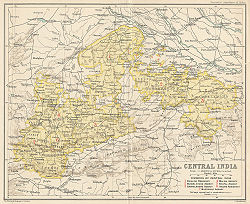Central India Agency
| Central India Agency | |||||
| Agency of British India | |||||
|
|||||
| Central India Agency in 1909 | |||||
| History | |||||
| • | Merger of previous political offices | 1854 | |||
| • | Independence of India | 1947 | |||
| Area | |||||
| • | 1881 | 194,000 km2(74,904 sq mi) | |||
| Population | |||||
| • | 1881 | 9,261,907 | |||
| Density | 47.7 /km2 (123.7 /sq mi) | ||||
The Central India Agency was a political office of the British Indian Empire, which covered the north-western half of present-day Madhya Pradesh state. The Central India Agency was made up entirely of princely states, which were under native rulers. The agency was bordered by the Central Provinces and Berar to the south; the Chota Nagpur princely states to the east, which were transferred from Bengal to the Central Provinces and Berar in 1905; the United Provinces of Agra and Oudh to the north; Rajputana to the northwest; and Bombay Presidency to the west and southwest. Lalitpur District, part of the United Provinces, split the Central India Agency into eastern and western portions.
The Central India Agency was created in 1854, by amalgamating the Western Malwa Agency with other smaller political offices which formerly reported to the Governor-General of India. The agency was overseen by a political agent who maintained British relations with the princely states and influence over them on behalf of the Governor-General. The headquarters of the agent were at Indore.
British hegemony over the states of Central India began in 1802, when several states in the Bundelkhand and Bagelkhand regions came under British control at the conclusion of the Treaty of Bassein between the British and the Maratha - Peshwa Bajirao II. British control of Bundelkhand expanded at the conclusion of the Second Anglo-Maratha War in 1805. The remaining states, including Gwalior, Indore, Bhopal and a number of smaller states in the regions of Malwa, Nimar, and Bundelkhand, came under British control with the end of the Third Anglo-Maratha War in 1818. The estate of Chanderi was ceded to the Sindhia ruler of Gwalior in 1844 by the British, and Jhansi State was seized by the British in 1853 under the doctrine of lapse was added to the United Provinces. In 1921 Gwalior Residency was separated from the Central India Agency, and in 1933 the state of Makrai transferred to Central India from the Central Provinces and Berar.
...
Wikipedia

